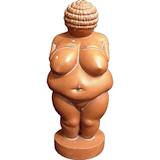 {Priestess/Goddess of Willendorf}
{Priestess/Goddess of Willendorf}
Word has it that archeologists have discovered no signs of violent death or warfare activity for 1500-3000 years within the archeological remains of Neolithic (before ~6000 BC) skeletons and building foundations, Catal Huyuk and Sumeria, for example, found in the Caucasus and the Fertile Crescent (the Romania-Turkey and NIle-Syria-Iraq-Iran areas of the globe). These communities are called matriarchal (or more appropriately matrilineal) because of their artifacts, for example:
- mother-infant sacred objects,
- mother-clan arranged communities,
- many female priestesses,
- practical items as high art (made beautiful with decoration: bowls, urns, baskets, furniture, etc.),
- communal sharing of surplus, mutuality with few express laws
As far as we can tell now, anyway. Contrast this with patriarchal artifacts found the last 5000 years, ~3000 BC to present; the Old Testament was likely written during the period 1500-250 BC. Patriarchal artifacts include, for example:
- male gods with names and myths,
- (slave-owner) male private ownership especially of communal surplus,
- not-useful luxury items as high art (expensive, rare, coveted),
- male-enforced and male-(slave)owner-benefitting laws
- laws that get more complicated and numerous as time passes.
 {Priestess/Goddess of Lespugue}
{Priestess/Goddess of Lespugue}
But let’s stop right there. Male v. Female? No, I don’t think that’s what ‘matrilineal’ communities were about.
Maleness is a sacred condition just like femaleness, and who’s to judge someone more a male than a female (not by their dangly parts, that’s for sure). Maybe we are seeing the huge archeological differences to be differences of mind-set like slavery&possession versus relation&interdependence, a relationship of taking-over versus well-being. Maleness is not inherently patriarchal. Subscribing to patriarchy is inherently patriarchal. Subscribing to relational wellbeing is inherently relationally being well, not some female characteristic to be put on a pedestal or (while) poopoo’ed as effete (not masculine — enough).
What would our lives look like if we and everyone around us were subscribing to Wellbeing, not to “enough-ness”? By this I mean what if abundance and life and self and relationship were not Things to fill-up (with happiness, for example)? What if abundance and life and self and relationship were practices where all of us consciously, constantly asked, “right this minute, how can I help you grow into a better (more aware, more joyful, less suffering) person without barging in on you?” What if we asked this just as naturally and habitually and constantly as we now — worry? That life gets my vote, and my imperfect practice of it at the present.
 {Priestess/Goddess of Cupertino}
{Priestess/Goddess of Cupertino}
Note: “Word has it…” sources:
- Erich Fromm. Anatomy of Human Destructiveness. NY: Holt, Rinehart & Winston, 1973.
- Marija Gimbutas. The Living Goddesses. Berkeley, CA: UC Press, 1999.
For an unapologetically matriarchal treatment of this topic enjoy:
- Monica Sjoo & Barbara Mor. The Great Cosmic Mother: Rediscovering the Religion of the Earth. San Francisco, CA: Harper & Row, 1987.
- Barbara Walker. The Woman’s Encyclopedia of Myths and Secrets. Edison, NJ: Castle, 1983.
I’m on a search, after my dissertation I promise, to gather up more recent discussions of this topic. Stay tuned.
For the Practice of Wellbeing, I used the definition of Love from the book I recommend above all others:
- Peck, M. Scott. The Road Less Travelled. NY: Simon & Schuster, 1978.
Do you have any favorite books about Neolithic communities, spirituality, or culture?
What would a day in a life of wellbeing practice look like for you?